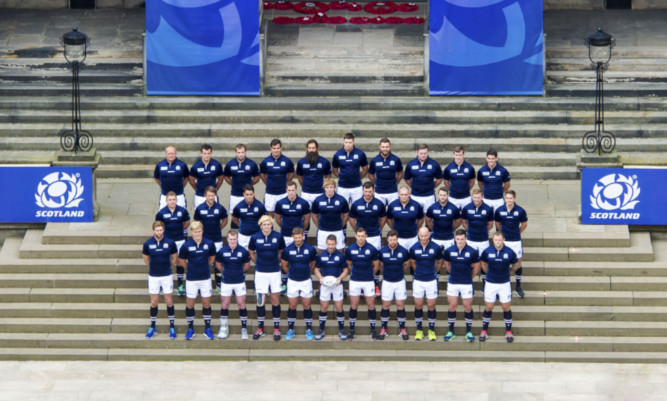Vern Cotter wanted power ahead of pace and finesse for Scotland’s World Cup campaign and that’s why he made the controversial decisions in the 31-strong squad named yesterday.
In front of a modest audience among the pillars and balustrades of the Old Quad at the University of Edinburgh, Cotter announced the back division largely expected and confirmed Greig Laidlaw as captain, but sprung a number of surprises in the forwards, not least picking just one specialist open side out of a possible five originally called up.
That specialist is John Hardie, parachuted into the squad at the eleventh hour. It’s no surprise the New Zealand-born former Highlander is in (why would they have brought him in if they weren’t going to pick him?) but it is a shock he’s the only 7 there as Blair Cowan the incumbent in the last eight competitive internationals and 42-times capped John Barclay are not.
Perhaps even more surprising is a recall for Tim Swinson, the combative Glasgow lock who was thought to be out of contention after falling out of training camp with an injured ankle. One game, a pre-season match for the Warriors against Canada in Nova Scotia on Saturday night, was apparently enough evidence for Cotter and forwards coach Jonathan Humphreys.
For Hardie, barely an hour against Italy in Turin confirmed all Cotter needed to know. “16 tackles and no misses” was the coach’s reasoning for preferring the import to his rivals.
It was not a fait accompli the minute Hardie made his belated arrival, insisted the coach.
“I said right from the start that he had to prove himself,” he said. “I just shook his hand and said if you’re good enough you’ll make it and if you’re not then you won’t.
“He didn’t say ‘boo’, he just got on with his work. He’s impressed us during live session in training and during the time he was on the field against Italy.”
Hardie had played at “a high level for a number of years” added Cotter.
“I only want Scotland to do well and I believe he has a profile that will help this team perform.
“He’s a specialist seven and gets into the right channels, is strong on the contact and can carry so I’d say he’s a good character too. All I want is the best team out on the paddock.”
Cotter agreed with the first three games of the pool covering only 10 days, that they’d probably have to start someone else at 7 in at least one game.
“We have within the group versatility,” he said. “Ryan Wilson can play seven. Fraser Brown and Stuart McInally can play loose forward as well. If we want to go even further, Richie Vernon has played there.”
The choice of Swinson ahead of Rob Harley was a real curveball, but reflects Cotter’s preference for power, underlined by Josh Strauss’s inclusion as the only uncapped player.
“There is no point in throwing your darts at the right places if they don’t have the weight to stick in the board,” continued the coach.
“It is about making sure you can impose your game on the opposition and, at the same time, resist theirs.
“I think people underestimate the power of the USA. They are a very big, strong team. Japan have collective power because they are so well organised. South Africa we all know about, and Samoa are the same.
“It is a bruising pool and if you can’t get a physical foothold against those teams, and let them get confident, then it is going to get difficult.”
Even Swinson didn’t expect the call, which came on Sunday when he was still suffering from jet-lag after flying back from Canada.
“I saw a missed call from Vern and thought he was just phoning round all the guys who’d been in the original squad,” he recalled.
“I finally got through to him and he gave me the news and I was really shocked. I didn’t know how to react because it was something which wasn’t even on my radar. It is a huge honour for me and I am so excited.”
Swinson had resigned himself to playing for Glasgow but now wants to give his all not just for the coaches who have faith in him, but the squad colleagues who have made and those who haven’t.
“It is the guys in the squad, from Greig, right down to the boys who unfortunately didn’t make the 31. I want to do my best in a Scotland shirt for everyone I have played with and played for.
“I certainly feel for them. Having gone through believing I wasn’t going to make it because of my injury, I know it isn’t a nice feeling. It is quite a tough time for those guys and hopefully I can support them as much as they have supported me so far.”
Cotter, meanwhile, has named the back division most expected, not including Alex Dunbar for whom a recovery from ACL surgery was just too tough a deadline to make. Richie Vernon, a late arrival as a forward in 2011, is the beneficiary as a back in 2015.
“We are not the type of people who are going to say we will win the World Cup,” added the coach.
“We are not the type who will say we are going to qualify but you can be damn sure we will be working hard to do the best we can to get out from our pool.
“That’s not part of our psyche as humility is very important to us. I can tell you they are very hard working and ambitious.
“Greig and the boys will quietly roll their sleeves up and get on with it.”
